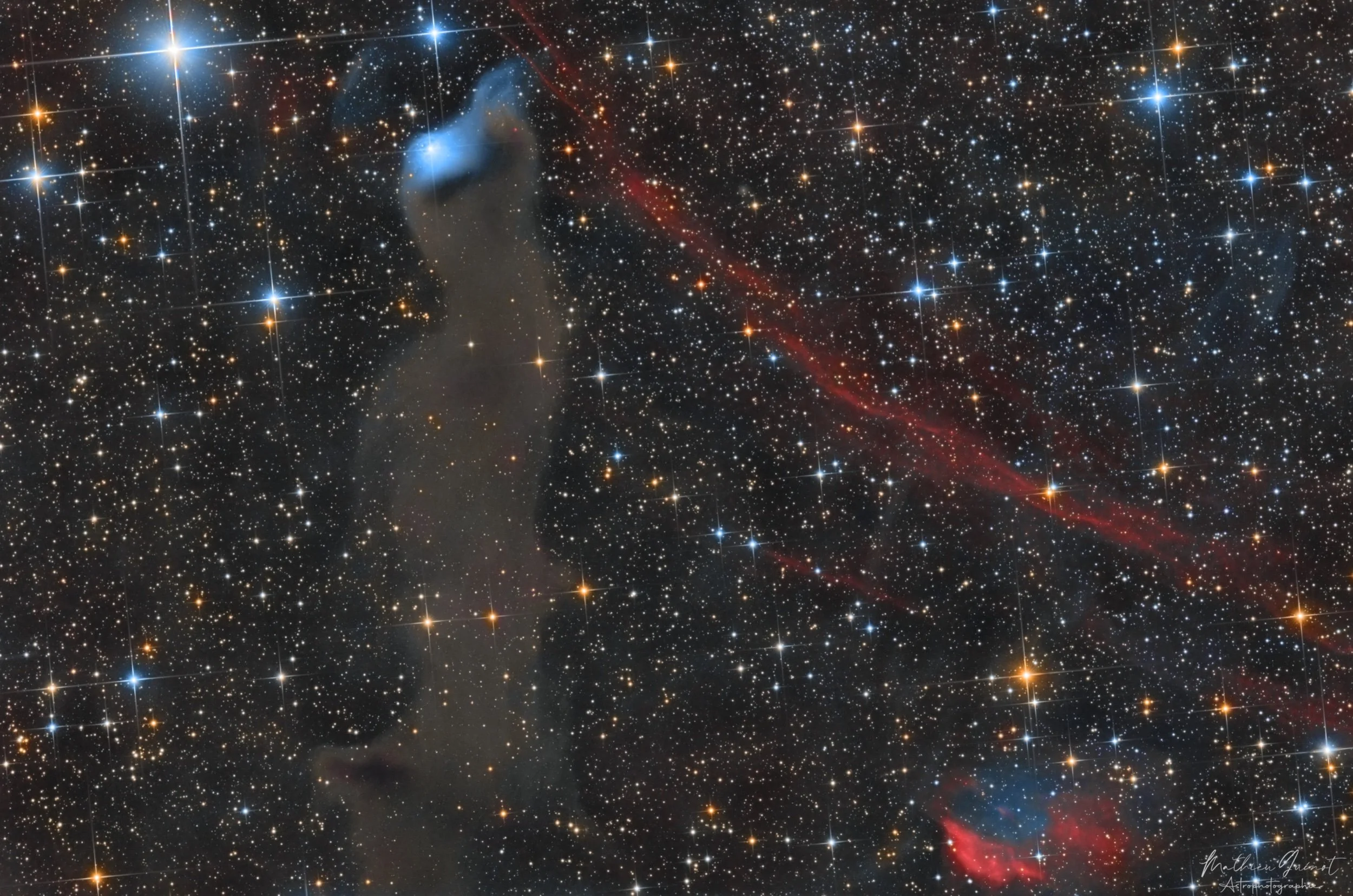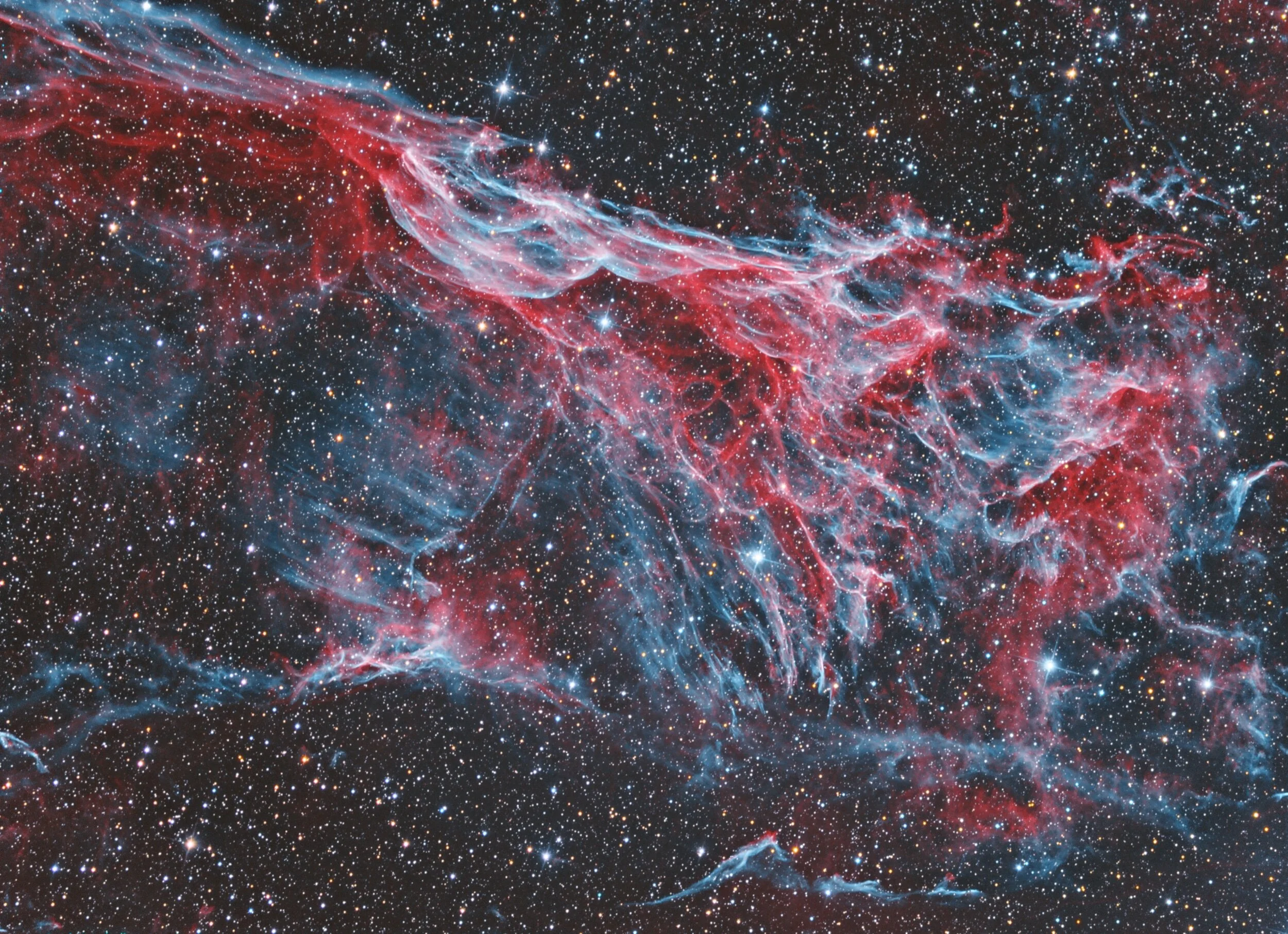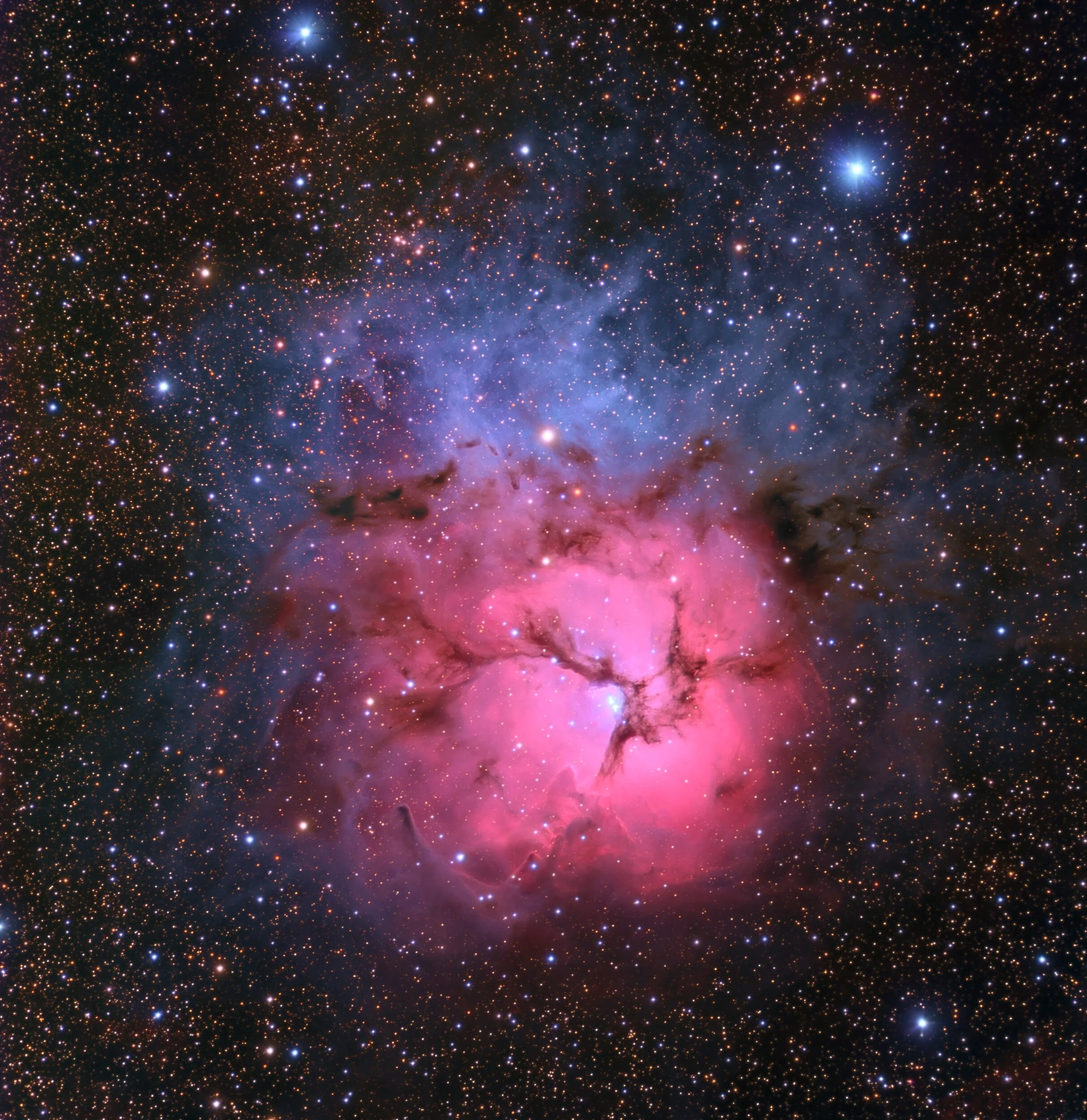
AAPOD2 Image Archives
NEW DISCOVERY: StDr 140 - Lori's Nebula in Gemini
Image Description and Details :
A new discovery of a candidate planetary nebula in the constellation Gemini. The object was discovered by my good friends the German-French team of Marcel Drechsler and Xavier Strottner in October 2021 using digital sky surveys. This is their 140th joint discovery. Currently, only very few planetary nebulae are known in the Gemini constellation, and now this impressive new nebula has been added. Because the PN candidate is rich in ionised oxygen (OIII), the object appears in a ghostly turquoise blue. It is at an estimated 4,250 light years from Earth.
My thanks to Marcel Drechsler for so expertly processing this image.
Image captured on my remote dual rig at Fregenal de la Sierra in Spain between 4-15 November 2021.
Scopes: APM TMB LZOS 152 Refractors
Cameras: QSI6120wsg8
Mount: 10Micron GM2000 HPS
A total of 76 hours 35 minutes image capture (HaOIIILRGB)
Copyright: Peter Goodhew
A Helping Hand
Image Description and Details :
This is the Helping Hand Nebula in Cassiopeia.The blue reflection is as a result of the Cepheid variable star SU Cassiopeia. Vdb 7,8 and 9 are present in this image as well as Ldn 1353, 1355 and 135812 Hours in 120 sub exposuresAsi 2600mc through a Takahashi Epsilon 160
Copyright: Richard Sweeney
VdB 152, Barnard 175 & Co
Image Description and Details : Here is a rich field located within the large molecular cloud of Cepheus.
This image was an experiment under my downtown sky, and i am rather happy with the result because, although having probably approached the limits of the Bortle 7 sky, it shows that urban astrophotography still offers possibilities with this type of object.
4 types of nebulae are visible in this image, against a background of nebulosities of interstellar dust:
- the dark nebula Barnard 175, a dense pillar of dust
- the reflection nebula Vdb 152, shining a characteristic blue at the top of this dark pillar
- the old planetary nebula DeHt-5 radiating mainly in the wavelengths of ionized hydrogen and oxygen (red and blue)
- part of the SNR 110.3 + 11.3 supernova remnant whose ionized hydrogen filaments (red) cross the field
Some distant small galaxies are visible in the background despite the density of this area of the Milky Way.
37h30 of exposures carried out in September and October 2021 in Amiens (Bortle 7) through LRVB filters supplemented by H and O filters for NP and supernova remanence with:
newton 250mm f / 3.8
CEM120 mount
Camera ZWO ASI 2600mm
Processing with Pixinsight and Photoshop.
L: 645 x 120s
RGB: 33x120s, 40x120s and 44x120s
H: 85 x 300s
O: 60 x 300s
Copyright: Mathieu Guinot
Floating beauty
Image Description:
27-8-2021 Moon age: 18.8 days Moon phase: Waning Gibbous LEB - Bortle 7 class -Rig Details: Celestron EdgeHD 9.25 on CGX Baader UV/IR cut filter ZWO asi224mc TV 2.5x powermate SharpCap
Copyright: Omar S. Rajji
NGC6979- Pickering's Triangle HOORGB
Image Description and Details : Ha : 91 x600". Gain 200. Bin1
[OIII]: 90x600". Gain 200. Bin1
RGB: 40x60". Gain 139. Bin1 (For stars color)
Total integration time: 32h10'
Data acquired on several nights of July and August 2021 from Belmonte and Naharros, Cuenca (Spain)
Equipment: ZWO ASI1600MM. Meade R8 200/1000. EQ6R-PRO.
Guiding: EZG60 + QHY5-L-II
Capture Software: NINA & PHD2
Processed with Pixinsight 1.8.8.7
Copyright: Alejandro López
M20 - NGC 6514 - The Trifid Nebula
Image Description and Details :
This is my image of the wonderful and iconic Trifid Nebula. It is about 4100 ly away and is 42 ly across.My 0.54 degree x 0.54 degree field of view, beautifully accommodates it.Capture details:Dates; 2021-04-22 to 2021-05-18Lights: 24.5 hours integrationLum: 32 x 600 secsRed: 23 x 600 secsGreen: 22 x 600 secsBlue: 22 x 600 secsBias: 35Darks: 35Flats: 20 per colour channel per camera changeThere are some very bright foreground stars, which I decided not to reduce too much through Morphological Transformation, as compositionally I feel they add a lot to the image. My image scale and advantageous latitude, which means the object was at a good altitude throughout the imaging runs, plus generally decent seeing meant that good resolution of detail was possible. I was particularly pleased to resolve the stellar jet as imaged by the HST. This is a Herbog-Haro object numbered HH 399.
Copyright: Niall MacNeill
A bubble in Hercules, Abell 39
Image Description and Details :
Abell 39 is a faint nearly symmetrical planetary nebula in Hercules. Exposures for Abell 39 taken from 3 April to 21 May 2021 from my backyard Observatory. 32.1 hrs of exposure time consisting of 160min of Red and Green, 140min of Blue, 700min of Ha and 760min of OIII. I used my Stellarvue SVX 152T with a ZWO ASI 6200 camera. Control was with Voyager automation. The images were taken using 1x1 binning for a resolution of .64 arcsec/pixel. The exposures were also done using a 1/2 frame ROI.
Abell 39 is the 39th entry into George Abell's catalog of planetary nebula. Within this field are an enormous amount of background galaxies, probably more than foreground stars. The image is a crop of a much larger field of view.
Copyright: Jon Talbot
Cederblad 111
Image Description and Details :
Cederblad 111 is a blue reflection nebula in the southern constellation of Chamaeleon and is part of one of the closest dark cloud complexes to the earth at only 550 Ly distance away. Cederblad 110 is the accompanying reflection nebula in this wide field image Both are part of Chameleon I molecular cloud complex. The small, elongated, bright red objects at the center of the image are Hebrig-Haro objects (HH 49-50), which form from a collision between ionized jets of gas ejected from newly born stars and the surrounding cloud. This area of the sky is rich in dust and Ha creating new bright stars within the dusty shroud. 40 x 900s Stellarvue SV80ST - ASI6200 - AP1600 Processed entirely in Pixinsights Imaged from Obstech Observatory El Sauce, Chile
Copyright: Simon Lewis
ISS TRANSIT
Image Description and Details :
I was able to photograph the iss again 4/2. I planned the shot about 3 weeks ago and with a little luck I was able to take it today at 4:41 pm. This is my 4x ISS transit photo, and every time I am fascinated and excited at the same time
Lunt LS80 DSII & Coronado BF30 Blockfilter
Rainbow RST-135
QHY5III174M Cam
Hutech Hinode Solar Guider
Meade Series 5000 2x Barlow
Copyright: Mehmet Ergün
A Sunflower in a Sea of Shattered Stars
Image Description and Details :
This image shows the galaxy M63, also known as the Sunflower Galaxy. What sets this galaxy apart from other spiral galaxies is its extensive halo and tidal stream. These streams often occur when a galaxy has a close encounter with a nearby satellite galaxy. The result is a big stream of remnants of the satellite galaxy.The image was taken throughout February(13.02, 18.02, 20.02, 22.02, 01.03.) and early March, party out of my backyard, party from a dark site, both located near Freiburg in Germany.The gear used was the following: Celestron RASA8, QHY183M, Skywatcher EQ6, TS-Optics LRGB filters. The exposures were mainly 90sec at Gain 0, though some had 60s subs because of the moon. Total integration time amounts to 25hours.Processing was mainly done in PixInsight, although I also used Adobe Photoshop and AstroPixelProcessor. The main challenge was to bring out all the faint dust without "blowing up" the stars and details, PixInsights multiscale processing certainly helped a lot in making that possible.
Copyright: Julian Shroff
NGC1333
Image Description and Details :
RECORDING DATA:Object: NGC 1333Date of recording: November 2020Distance: 1,000 light yearsExposure: 144 x 300 sec. (Total 12 hours)Calibration: Darks / Flats / DarkFlatsMount: Skywatcher EQ6-R PROTelescope: Lacerta Fotonewton 250/1000Corrector: Lacerta GPU coma correctorFilter: Astronomik L2 UV-IR Block 2 ″Camera: QHY268c @ Gain 0 at -15 ° CGuiding: ZWO OAG with ASI 120mm-s and PHD2Software: APP / Photoshop CC
Copyright: Daniel Nimmervoll
M42 and IC 434 widefield in Narrowband
Image Description and Details :
This image shows the Orion Nebula, De Mairan’s Nebula, the Horsehead Nebula and the Flame Nebula. It was taken with a small refractor telescope from the city. For this, narrowband filters were used and long exposure times helped reveal a lot of gas and dust all around the nebulae. The color was achieved by combining the narrowband channels into a “OHS” combination. This is rarely done and gives this part of the sky a unique look. Other combinations (Hubble Palette or true color) did not really make the objects pop as much. I believe the OHS combination is the best when it comes to imaging this section of the sky in narrowband only, although it is either you love it or you hate it!
Copyright: Antoine and Dalia Grelin












